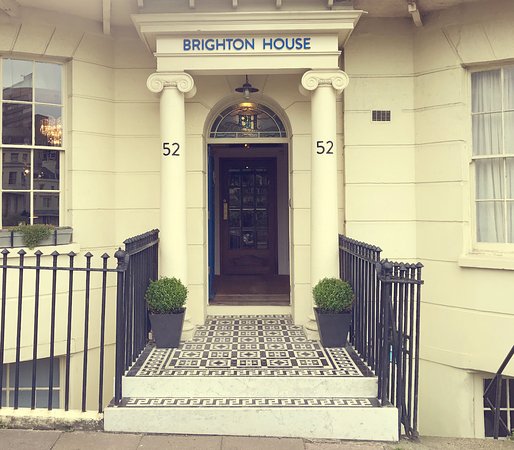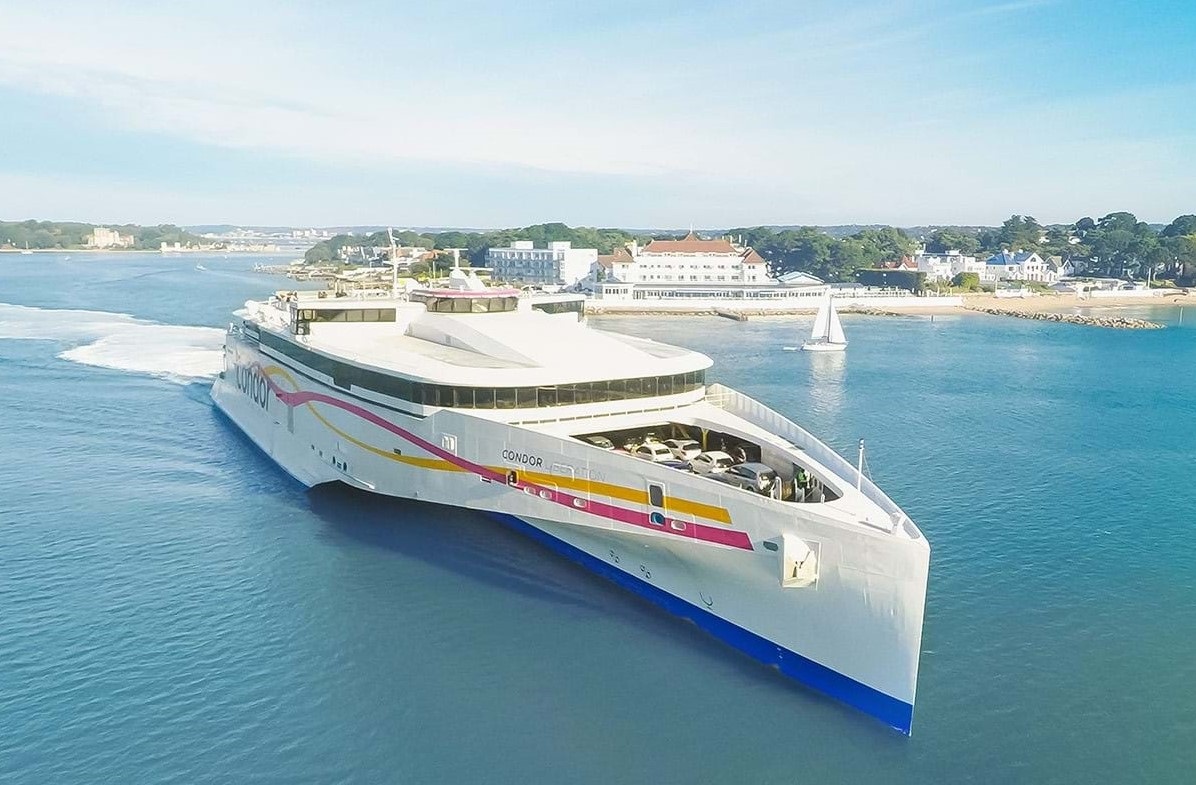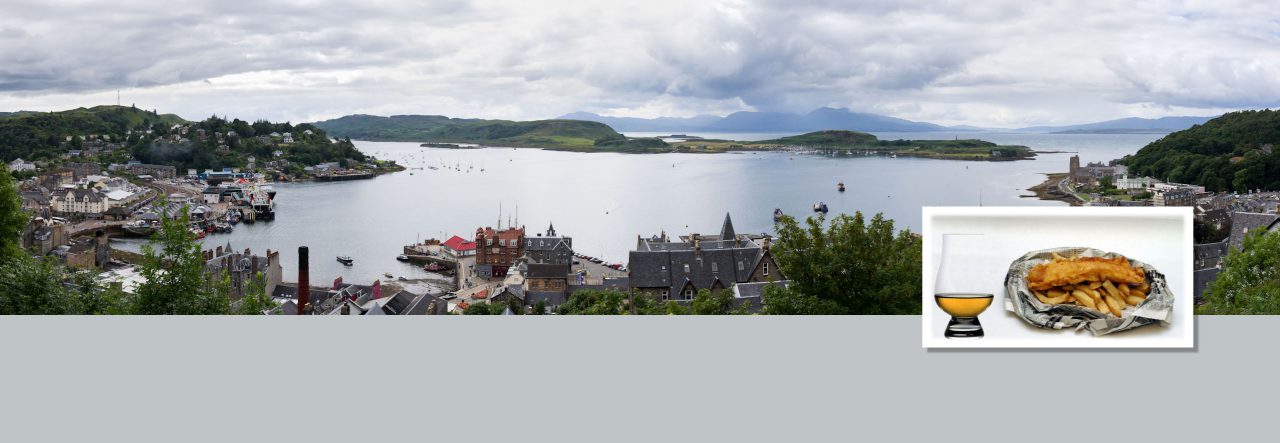In which I discover that standing on the deck of a ferry moving at 30 knots in the middle of the English Channel on a particularly windy day is categorically the best time to wear a trenchcoat for dramatic effect. Also, ferries have barf-bags, which was a really good thing.
 Our overnight stint in Brighton required nothing much more than a bed to sleep in and an early morning meal before our departure. Bed and a breakfast, so to speak. Fortunately, a number of establishments seem to have caught on to this notion, and we had exactly such a reservation at a “Bed & Breakfast” (clever, huh?) called Brighton House. It was, in fact, a house. In Brighton. So, you know, truth in advertising. ‘Twas a nice, older house that has been done up for folks like ourselves, and our room offered three single beds which was perfect for momma, poppa and baby bears, all of whom slept just right.
Our overnight stint in Brighton required nothing much more than a bed to sleep in and an early morning meal before our departure. Bed and a breakfast, so to speak. Fortunately, a number of establishments seem to have caught on to this notion, and we had exactly such a reservation at a “Bed & Breakfast” (clever, huh?) called Brighton House. It was, in fact, a house. In Brighton. So, you know, truth in advertising. ‘Twas a nice, older house that has been done up for folks like ourselves, and our room offered three single beds which was perfect for momma, poppa and baby bears, all of whom slept just right.
Our itinerary required us to catch a noon ferry in Poole, about 102 miles away. Vehicle check-in closed at 11:00am, so we wanted to be there by 10:30am, since it was a new ferry company for us (Condor Ferries). We were looking at a couple of hours on the road as this would be commuter time, and much of the trip took us through the center of various towns. Not many bypasses to speak of. Mr Dent would have been quite happy in this part of the country; Mr Prosser would have been equally happy just looking at all those wonderful possibilities.
Anyway, this all meant that we wanted to be leaving Brighton no later than 8:30am, so early brekky it was. At 7:30am, we were the first in line when they opened the breakfast room, and we entered to one of the nicest spreads I’ve seen at a B&B in a long time. Proper continental breakfast; not that watered down orange juice and stale Pillsbury croissants that passes for “continental breakfast” in the States. Cured meats, selection of cheeses, various croissants, breads, scones, cereals, juices, milks, home-made yoghurt, and more and more and more. It was delicious. I highly recommend this place.
But, we couldn’t lounge. We ate our fill, grabbed our bags, and scarpered. Traffic was much as expected. The in-car navigation system disagreed with the jPhone’s Google maps on several points, but we kept the AI’s apart so they just grumpily took turns recalculating our route, and we made it to the Condor Ferry terminal in Poole pretty much right when we wanted to.
Check in was a doddle, and we only had a wait a few minutes before being boarded. That is, we were told to board the ferry. Our Renault was not in fact boarded by employees of Condor Ferries bearing cutlasses and hand-held ticket scanners. That would have been strange. We parked up close and personal, as is the way on these boats, then made our way up to the passenger levels.
Our transport for the day was the Condor Liberation (which I keep typing as Condor Libation, for reasons that you’ll have much more fun making up than me). The Liberation is a trimeran – multi-hull with a main (center) hull and two smaller hulls on the outsides – capable of over 40knots. I believe that she’s been clocked at 41 knots in service, but sits at around 30 knots for most crossings. With a stop at Guernsey on the way to Jersey, the route is about 120 miles. The Liberation therefore makes the crossing in a speedy 4 hours & 20 mins.

I’d upgraded our tickets to Ocean Plus, which meant that we were at the front of the boat, with a tables and a view. Pretty comfortable seats as well. And plenty of sick bags to go around. Which turns out to be A Good ThingTM. You see, the trimeran configuration means that the boat rocks, more than usual. Actually, technically, it’s roll. Rock or roll! As the boat gains speed, I’m told that it rises out of the water somewhat. This itself makes for some rather disconcerting thumps, as waves smack against the raised hulls every so often. But the additional rolling comes from the fact that, on anything other than dead calm seas, balance shifts from one secondary hull to the other, pivoting on the main (center) hull. Not violently, or rapidly, but inevitably. Add in the expected pitch (bow to stern) of the sea, and you have quite the fluid motion (geddit?). A little too fluid for a number of our fellow passengers, unfortunately. Nothing to beat the smell of fresh bile to trigger your own contribution. Fortunately, my ladies had both taken Dramamine in anticipation of 4 hours on a boat, and I’m happy to say that my ferry rides as a kid have set me in good stead. I decided not to eat too much, just in case, especially with the ambient aromas, but basically I was just fine.
Interestingly, when the Liberation went into service on the Channel Island runs, many passengers complained about this aspect of the boat. Some Jersey-bound passengers were reported to have abandoned their cars at the Guernsey stop just to get off the boat asap. They even raised safety concerns, and there was a brief investigation, the result of which was that the boat was declared perfectly safe, and passengers advised to “retrain their stomachs”. Useful advice, said exactly no-one, but you get what they meant.
The real fun of the trip came when we ventured out on deck. Remember, this boat is clocking 30 knots. Add to that the decently strong winds of the English Channel, and all the rocking and rolling. What you have is a great fun balancing challenge with added gale force winds. My trenchcoat looked utterly spectacular, though if I’d held it taught, I may actually have taken off. They could probably have flown me like a kite to keep the seagulls away. Actually, no seagulls anyway – there’s no way the buggers could keep up!
We arrived in Jersey and made our long, arduous way across the island to my sister’s place. The island is a whopping 9 miles long and 5 miles wide, so this took us about 15 mins. Though, to be honest, I took my time because those Jersey roads are tight!
A word about driving on Jersey. I grew up being driven on, biking on, and eventually driving myself on British country roads. By US standards, they’re small, but just fine for European sized cars. Country roads, of course, include single-track, which I’m also quite comfortable on. Jersey roads, on the other hand, are a whole new dimension. Or, rather, seem to be lacking one. What genuinely look like single-track roads to most Brits are often two-ways on Jersey. The standard British country two-ways would scare the living excrement out of the average American driver. That same driver would just stop, stare and flat-out refuse to drive down the Jersey ones even before they realized they were supposed to fit two cars side-by-side. So, here I was, in my mini-SUV, reminding myself how to drive these roads. Basically, keep the vehicle juuuust to the left of the center line (UK, remember) and trust that there will be space between the passenger side wing mirror and the wall / hedge / whatever. Passing an oncoming lorry (truck) at speed is an exercise in self-control and remembering that “if they fit, I fit”. I swear that my non-religious wife crossed herself, more than once.
I tried to ignore the nav system to see if I could get myself to Pam’s house, and was pleasantly surprised to find that I could, more directly than Google maps, though possibly along a couple of tighter roads.
We arrived, and our hosts let us in, which was nice as they’d had security gates installed since our last visit. Our hosts, of course, were my sister Pam, her hubby Lee, and the miracle twins Mackenzie and Cameron. We just chilled at the end of the day with dinner, drinks, and chatting to catch up.
Not much more to say for now, so I’ll sign off at the start of Chapter 1.

Leave a Reply